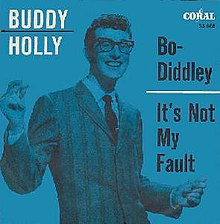Bo Diddley (Bo Diddley song)
| "Bo Diddley" | ||||
|---|---|---|---|---|

Single reissue with picture sleeve, Checker Records
|
||||
| Single by Bo Diddley | ||||
| B-side | "I'm a Man" | |||
| Released | April 1955 | |||
| Format | 7-inch 45 rpm, 10-inch 78 rpm | |||
| Recorded | March 2, 1955 | |||
| Studio | Universal Recording Studios, Chicago, Illinois | |||
| Genre | Rhythm and blues, rock and roll | |||
| Length | 2:27 | |||
| Label | Checker 814 | |||
| Songwriter(s) | Ellas McDaniel a.k.a. Bo Diddley | |||
| Producer(s) | Leonard Chess, Phil Chess, Bo Diddley | |||
| Bo Diddley singles chronology | ||||
|
||||
| Audio sample | ||||
|
30 second sample of "Bo Diddley"
|
||||
| "Bo Diddley" | ||||
|---|---|---|---|---|
 |
||||
| Single by Buddy Holly | ||||
| from the album Reminiscing | ||||
| B-side | "It's Not My Fault" | |||
| Released | 1963 | |||
| Format | 7-inch 45 rpm | |||
| Recorded | 1956 and 1962 (overdubs) | |||
| Studio | Norman Petty Recording Studios, Clovis, New Mexico | |||
| Genre | Rock and roll, rockabilly | |||
| Length | 2:23 | |||
| Label | Coral | |||
| Songwriter(s) | Ellas McDaniel a.k.a. Bo Diddley | |||
| Producer(s) | Norman Petty | |||
| Buddy Holly singles chronology | ||||
|
||||
"Bo Diddley" is a rhythm and blues and rock and roll song first recorded and sung by Bo Diddley at the Universal Recording Studio in Chicago and released on the Chess Records subsidiary Checker Records in 1955. It became an immediate hit single that stayed on the R&B charts for a total of 18 weeks, 2 of those weeks at #1, and seven more weeks than its flipside (the B-side, "I'm a Man"). It was the first recording to introduce African rhythms into rock and roll directly by using the patted juba beat. It was Diddley's first recording and his first hit single. The song is featured on many of Diddley's compilation albums including His Best.
In 2012 the A and B-side pair were added to the Library of Congress's National Recording Registry list of "culturally, historically, or aesthetically important" American sound recordings. In 2017, the single was inducted in to the Blues Hall of Fame.
The song is rhythmically similar to hambone, a technique of dancing and slapping various parts of the body to create a rhythm and song. It is lyrically similar to the traditional lullaby "Hush Little Baby". When Diddley started playing with it, his electric guitar amplified the patted juba with his backup musicians on maracas and drums unifying the rhythm. This combination of rock and roll, African rhythms and sanctified guitar chord shouts was a true innovation and is often called a Bo Diddley Beat.
...
Wikipedia
